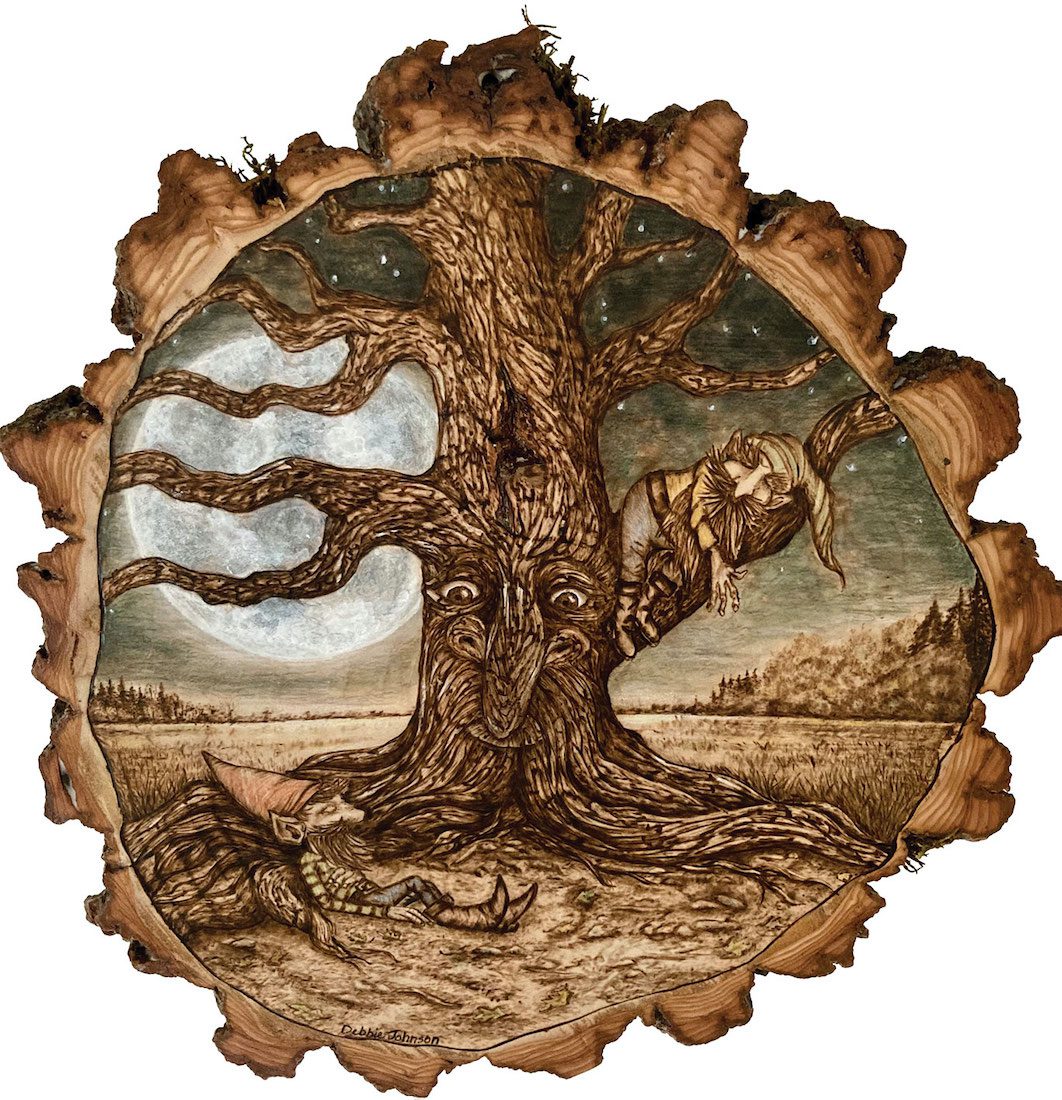
02 Jul Where There’s Smoke, There’s Art
Pyrographer Debbie Johnson burns Tahoe’s natural wonders into wood
If you have a dead weeping willow on your property, please tell Debbie Johnson.
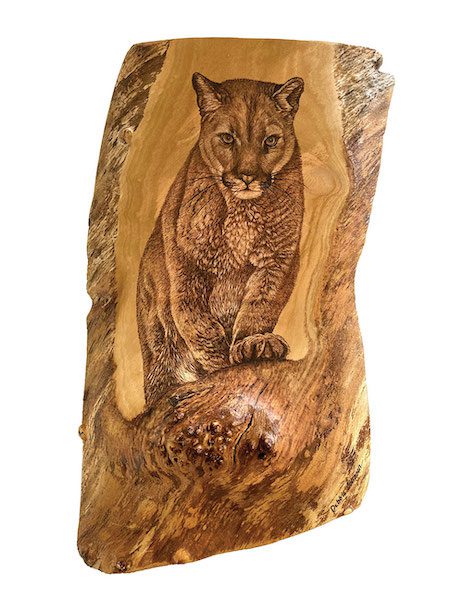
Johnson created a mountain lion from a piece of plum wood given to her by fellow North Tahoe Arts artist Todd Williams, courtesy photo
The 64-year-old part-time Tahoe resident is always on the lookout for tree limbs and trunks she can cut into slabs to use in her art. Why willow? It’s easy to sand, she explains—unlike maple, which can take more time and energy. She’s also searching for some linden wood, which she describes as light and lacking grains.
In the meantime, she has plenty of random scraps and pine planks to burn.
No, Johnson is not a bonfire-based performance artist. She’s a pyrographer, which literally translates to “fire writer.”
Armed with a woodburning pen—like a calligrapher’s implement, but much, much hotter at the tip—Johnson chars and smolders the wood’s surface as she draws mountains, trees, water, snow, pinecones and a diverse array of animals that call the forest home. Johnson, who owns a second home in Tahoe City with her husband but resides in Meadow Vista near Auburn, finds plenty of inspiration by simply existing in her community.
A chunk of wood with a knot on one side recently inspired an elk head, while a 6-foot-wide plank gained an eagle with outstretched wings. Most of her creations are smaller, with some taking the form of nothing more than a tiny eye peeking through a hole.
While Johnson’s images and scenes are typically based in reality, she also sometimes branches out into cryptozoology.
“I may throw a Bigfoot in there, or a gnome,” she says with a laugh, “and those are fun, too.”
Burning Beginnings
Johnson has long enjoyed art, and she can supply an appropriately long list of areas in which she’s dabbled over the years, including oils, acrylics, ceramics (“I got myself a kiln, got a wheel, and then suddenly I exited”) and stained glass. After failing to be captivated by these more conventional media, she wanted to try her hand at carving or painting gourds, which she found grew like crazy in her garden—“like 3 feet a day!”—but didn’t really appeal to her. The local deer wouldn’t even eat them.
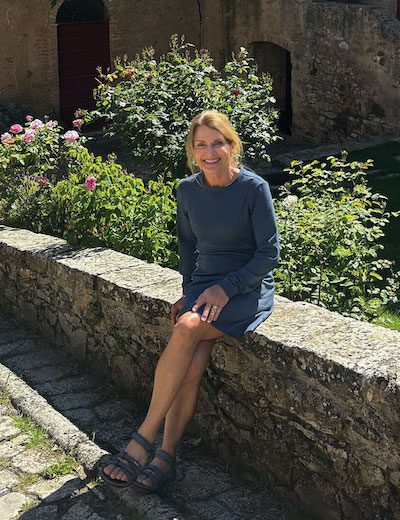
A longtime artist, Debbie Johnson discovered her love for pyrography in 2018, courtesy photo
“I did a few and thought, ‘This sucks,’” Johnson says. “They smell weird.”
Pivoting away from gourds, Johnson decided to try some woodburning around 2018, creating little works of art on scraps that she then gave away. Soon after, her daughter Becky was displaying her own watercolors in a show in Nevada City and suggested that her mom “fill in” some space at the gallery with the woodburning work.
“So I made a bunch, and they all sold!” Johnson says. “I was like, ‘Wow, that’s crazy!’”
Emboldened enough to go all in on woodburning, she started using a little kit from a craft store to make more. Now, she jokes that she’s gone professional with her Colwood burner featuring different tips for fine lines and shading. She even uses alcohol inks to add color to certain pieces.
As for materials, she’ll be driving and see a broken-off branch, then wonder if the property’s owners would care if she came back and hauled the downed wood out of the yard. Her retired husband does most of her woodcutting. She also gets interesting scraps to use as canvases from woodturner Todd Williams, who shows at North Tahoe Arts in Tahoe City, where Johnson is a permanent artist.
“He gives me all sorts of cool wood pieces that he cuts off logs to prepare for his wood lathe,” says Johnson, who has been asked to show elsewhere, including in Grass Valley, but prefers Tahoe. After all, she can sit in the gallery as she works and see the lake.
Building a Fire
Johnson is entirely self-taught, applying pen-and-ink skills she developed through prior forays into artistic expression. Thanks to today’s digitally interconnected world, she was able to visit artists’ websites and watch videos on Instagram to discover techniques and develop her craft.
She says woodburning is a bit similar to tattooing, and just like people, every tree is different. Some woods don’t burn evenly at all, she says, while others allow the tool to easily glide across their surface.
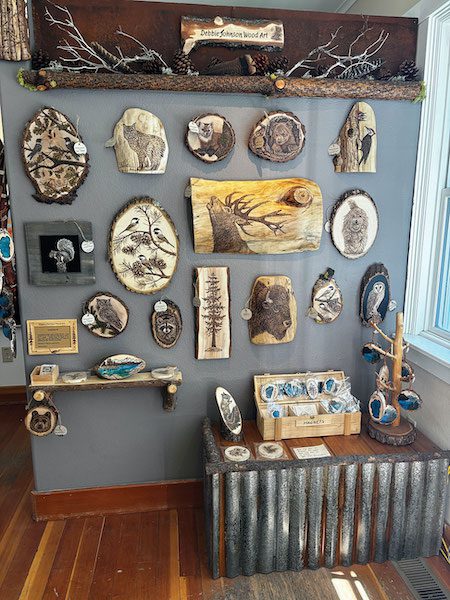
Johnson’s display at North Tahoe Arts in Tahoe City, courtesy photo
“Soft woods, like pine, if they’ve got any rot, they’ll burn,” she explains, describing a sudden, growing dark spot that can appear if her tool’s tip snags in a hole. “Oak, you can’t really burn on, because the grain is so hard. It doesn’t burn smooth. Softer woods are easier—not balsa wood—but you have to be careful about digging in too deep.
“If I make a terrible mistake,” she continues, “I can always sand it off, unless it’s really deep. Every wood is different. I start slow and see how it’s going to burn.”
Pine can be challenging due to sap. For harder woods, she has to make sure to burn her images as dark as possible, because the marks fade if they’re not heavy enough. The fading happens faster if the finished piece sits in direct sunlight, so she includes warning stickers on the backs of the scraps.
Processed wood is a definite no. Johnson avoids plywood and materials that would create a toxic haze as they smoldered. She has burned on old barnwood before, but she took it outside due to the smoke. For everything else, she typically just works in her office and runs an air purifier.
In addition to getting to know the feel of the wood, she’s also developed a sense of the smell of its smoke. There’s less smoke than one might think throughout the process, unless she’s drawing something very dark. Still, she does admit that some woods smell better than others.
“Some of it smells really good, like burning cherry wood. It’s like a smoker, like you’re smoking meat or something,” she says.
Her son cut down a maple tree last year, she adds, and she milled it and burned on it, but it doesn’t smell as good. Cedar is nice but doesn’t burn that well.
Burning to Last
After years of practice, Johnson can make an average piece in about four or five days. She takes a day to figure out what she wants to do with a particular piece of wood, then another to cut it to size, prep it and maybe draw an outline of her desired image. Depending on how big it is, she can take up to three days burning the picture. And once she starts one piece, she works on it until it’s done. She doesn’t hop around.
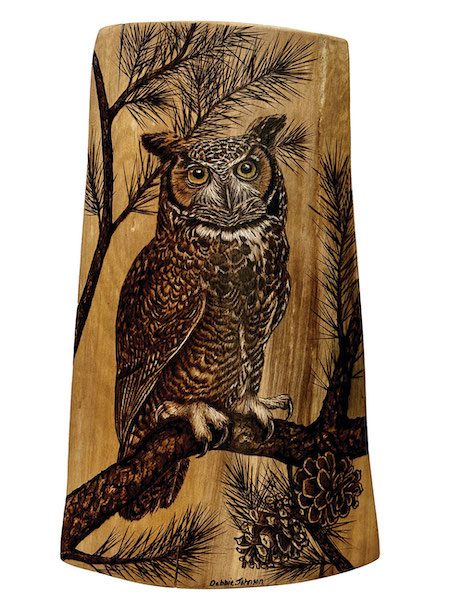
Johnson says she wakes up every morning to the sound of great horned owls outside her home, which inspired this piece of art, courtesy photo
After finishing the burning, she paints the wood in Mod Podge, a nontoxic sealer and finisher beloved by crafters. Several coats preserve the image well, and she’s learned from experience that this particular brand won’t change any pigments she used.
If, throughout the process, she encounters a detail that doesn’t look right to her, she’ll add to it until she fixes it, or she may redo a small area.
“Sometimes I have to sand off their eye or something because their eye looks weird,” she said of her burned creatures.
Even if she’s not happy with the end result, she never burns the piece, because her wood bits are too precious to her. Instead, she sands it all the way down and starts over, maybe after cutting the wood into a new shape.
“I had a Native American lady I had a picture of,” she remembers. “I liked it, but it didn’t sell. I reduced the price, moved it around to another gallery. I had to sand her off. Now she’s a barn owl. I know she’s still there.”
For as critical as Johnson is of her own work, her fans are far more accepting. She creates custom pieces with which she’s never satisfied, she says, though the buyers seem happy.
“They say they are,” Johnson says. “I just have to trust them!”
Ryan Miller is a Sacramento-area writer and editor. Follow him on Instagram or X, @jesteram.




No Comments